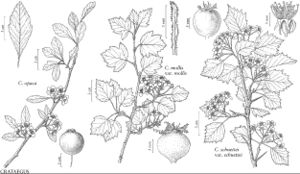Difference between revisions of "Crataegus mollis var. mollis"
FNA>Volume Importer |
imported>Volume Importer |
||
| Line 3: | Line 3: | ||
|accepted_authority= | |accepted_authority= | ||
|publications= | |publications= | ||
| + | |special_status={{Treatment/ID/Special_status | ||
| + | |code=F | ||
| + | |label=Illustrated | ||
| + | }}{{Treatment/ID/Special_status | ||
| + | |code=E | ||
| + | |label=Endemic | ||
| + | }} | ||
|basionyms= | |basionyms= | ||
|synonyms={{Treatment/ID/Synonym | |synonyms={{Treatment/ID/Synonym | ||
| Line 61: | Line 68: | ||
|publication title= | |publication title= | ||
|publication year= | |publication year= | ||
| − | |special status= | + | |special status=Illustrated;Endemic |
| − | |source xml=https:// | + | |source xml=https://bibilujan@bitbucket.org/aafc-mbb/fna-data-curation.git/src/bb6b7e3a7de7d3b7888a1ad48c7fd8f5c722d8d6/coarse_grained_fna_xml/V9/V9_933.xml |
|subfamily=Rosaceae subfam. Amygdaloideae | |subfamily=Rosaceae subfam. Amygdaloideae | ||
|tribe=Rosaceae tribe Gillenieae | |tribe=Rosaceae tribe Gillenieae | ||
Revision as of 00:34, 28 May 2020
Stems: twigs ± straight; thorns on twigs absent or few. Leaf blades ovate to broadly elliptic, lobes 2–4 per side, sinuses shallow (LII 8–20%), lobe apex subacute to obtuse. Stamens (10 or)20. Pomes red. 2n = 34.
Phenology: Flowering Mar–May; fruiting Sep–Nov.
Habitat: Brush, woodland edges, open woodlands, mesic habitats in grasslands
Elevation: 50–400
Distribution

Ont., Ala., Ark., Ill., Ind., Iowa, Kans., Ky., La., Mich., Minn., Miss., Mo., Nebr., N.Dak., Ohio, Okla., S.Dak., Tenn., Tex., Wis.
Discussion
Forms of var. mollis with smaller leaf blades (4–6 cm) of varying shape, characterized by subacute apices, often more or less cuneate bases, triangular lobes, thinner texture, and usually smaller flowers (15 mm diam.) match the type of Crataegus gravida (the form chosen for the C. mollis illustration) and appear to constitute a more or less distinct race of open or light woodlands in Alabama and Tennessee. Forms described as C. sera are similar to typical mollis but have thinner leaves. A form similar to the Ozarkian C. transmississippiensis, also having ten stamens, and commonly three styles, has been found in Minnesota, where it was called C. submollis (W. R. Smith 2008).
Selected References
None.
